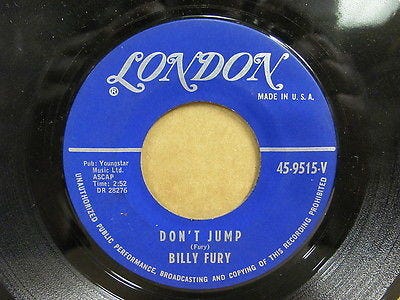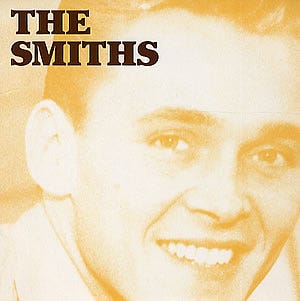'Shakespeare's Sister' is the Smiths' 7th single, released in the UK on March 18, 1985. The single reached No. 26 in the UK Singles Chart. It is also featured on the compilation albums Louder Than Bombs and The World Won't Listen.
The single came in both 7-inch and 12-inch versions, with 'What She Said' on the B-side, as well as the inclusion of 'Stretch Out And Wait' on the 12-inch B-side.
The 7-inch version had "HOME IS WHERE THE ART IS" etched on its A-side matrix, with the B-side having one of two variants etched on its Matrix: "timtom" and "TimTom". The 12-inch version had an identical etching on its A-side matrix, but there are variants with "HOME IS WHERE THE ART IS "Damont"". Some B-side's of the 12-inch had "Damont" etched on the matrix.
The cover art of the single features former Coronation Street1 star Pat Phoenix2, appearing as her character Elsie Tanner.
Listen to ‘Shakespeare’s Sister’ here:
According to Morrissey in Autobiography:
“‘Shakespeare’s Sister’ bursts out one night in a snowbound studio in Surrey. I felt we had out-stripped ourselves once again, and I loved Andy’s cello denouement. To his credit, Geoff [Travis, owner of the Smiths’ record label, Rough Trade] jumped into his battered Astra and chugged his way through a blizzard to hear the song at the studio, but he is not impressed with it. He lays out his compromise: ‘I’ll release this as a single if you give me approval for ‘How Soon Is Now?’ to come out first - as an A-side.’ In the event, neither ‘Shakespeare’s Sister’ nor ‘How Soon Is Now?’ troubles the Top 20 […] The Smiths are repeatedly pointed to as the hottest band in the country, yet we cannot respond with a visible hit single.”
Morrissey went on to attribute the underperformance of ‘Shakespeare’s Sister’ to insufficient promotion of the single on the part of Rough Trade, claiming the label "released 'Shakespeare's Sister' with a monstrous amount of defeatism".
Marr saw the underperformance of the single from a somewhat different perspective:
"It didn't surprise me that a song like 'Shakespeare's Sister' didn't get in the charts. It was a very arch record to release at that time. Quite audacious, a bit mad. That's why I loved it."
Mike Joyce remembers the battle over releasing the song as a single, stating:
“We didn’t always choose the right singles. ‘How Soon Is Now?’ was originally a B-side remember.” Joyce added that “Geoff Travis was very sniffy about the length of ‘Shakespeare’s Sister’ but the fact people said we were wrong only fired us up.”3
According to an anonymous employee of Rough Trade’s distribution network, it was an “open secret” that the Smiths released ‘Shakespeare's Sister’ as an act of revenge on Rough Trade, who they saw as having mercilessly exploited ‘This Charming Man’, releasing endless mixes and remixes. Apparently, its release as a single was the Smiths’ two finger gesture to Rough Trade.
"The greatest thing is the work, which you should build on, have a sense of momentum. You understand that intellectually when older but emotionally when you're young. What's the alternative? For me, 'Shakespeare's Sister' was pulling an odd star out of the sky. I had imagined this strange song and strange sound. Morrissey encouraged me and then we captured it. It was a statement of solidarity between us four and I was extremely proud of that togetherness." -Johnny Marr, Mojo Magazine, 2011
"'Shakespeare's Sister' - regardless of what many people feel - was the song of my life. I put everything into that song and I wanted it more than anything else to be a huge success and - as it happens - it wasn't. We can talk about independents and majors till the end of the day - but ultimately, when you make a good record, you want it to be heard."
-Morrissey
Record Mirror 1985
The title of the single appears to be inspired by Virginia Woolf's4 feminist essay, 'A Room of One's Own'. Woolf's essay asserts that if William Shakespeare had had a sister of similar genius, she would not have been afforded the opportunity to make use of it due to her gender. Sean O'Hagan (an Irish writer for The Guardian and The Observer) has said that Woolf's essay was "one of the many feminist texts Morrissey embraced as a sexually confused, politically-awakened adolescent".
There is also a compelling argument that the title of the single was inspired by the characters in 'The Glass Menagerie', a 1944 play by American playwright and screenwriter Tennessee Williams5. In the play, the character of Laura Wingfield is referred to as "Shakespeare's sister" by the character Jim O'Connor because the latter refers to Laura's brother Tom, an aspiring writer, as "Shakespeare."
British author and music journalist Simon Goddard has pointed out that the lyric "Young bones groan, and the rocks below say, 'Throw your white body down" is possibly inspired by a passage in Elizabeth Smart's novella 'By Grand Central Station I Sat Down and Wept' (a book which has been found to be a fount of considerable influence for the lyrics of several Smiths songs). Specifically, "Why do I not jump off this cliff where I lie sickened by the moon? I know these days are offering me only murder for my future. It is not just the creeping fingers of the cold that dissuade me from action, and allow me to accept the hypocritical hope that there may be some solution."
Goddard has also pointed to the lyrics of the Billy Fury6 1962 song 'Don't Jump' as an inspiration. This Billy Fury song starts with the following lines:
I was standing on the edge of the cliff top high above
I was looking right down below
I was thinking all about the women I had
About the women that I love so
But it's a long, long way to fall
Listen to ‘Don’t Jump’ by Billy Fury here:
Coronation Street is a British television soap opera shown on ITV since December 1960 (an astounding 63 years with over 12,000 episodes as of the date of this post). The show centers on a street in the fictional Weatherfield, a town based on inner-city Salford, England. Initially influenced by the conventions of kitchen-sink realism, Coronation Street is noted for its depiction of a down-to-earth, working-class community, combined with light-hearted humor and strong characters.
Patricia 'Pat' Phoenix (born Patricia Frederica Manfield (1923 – 1986) was an English actress who became one of the first sex symbols of British television through her role as Elsie Tanner, an original cast member of Coronation Street, a role which she portrayed from its first episode in 1960 until she quit the role in 1984.
Phoenix died of Lung cancer in her sleep, aged 62, on September 17, 1986
Far Out Magazine, November 2023
Adeline Virginia Woolf (née Stephen; 1882 – 1941) was an English writer. She is considered one of the most important modernist 20th-century authors. She pioneered the use of stream of consciousness as a narrative device.
On March 28, 1941, Woolf drowned herself by placing a large stone in her pocket and then walking into the fast-flowing River Ouse in North Yorkshire, England. Her body was not found until three weeks later. Woolf’s cremated remains were buried beneath an elm tree in the garden of her home in Sussex, England.
Thomas Lanier Williams III (1911 – 1983), known by his pen name Tennessee Williams, was an American playwright and screenwriter. He is considered among the three foremost playwrights of 20th-century American drama.
On February 25, 1983, Williams was found dead at age 71 in his suite at the Hotel Elysee in New York City. It was reported that Williams had choked to death from inhaling the plastic cap of a bottle of the type used on bottles of nasal spray or eye solution. The report was later corrected to state that Williams had been using the plastic cap found in his mouth to ingest barbiturates, and had actually died from a toxic level of Seconal.
Ronald Wycherley (April 1940 – 1983), better known by his stage name Billy Fury, was an English musician. An early star of rock and roll, Fury equaled the Beatles' record of 24 hits in the 1960’s, spending 332 weeks on the UK chart.
After returning from a recording session in the early hours of January 28, 1983, Fury collapsed from a heart attack at his home in London. His manager found him unconscious the next morning. He was taken to hospital, but died later in the afternoon, aged 42. Rheumatic fever, which he first contracted as a child, damaged his heart and ultimately contributed to his death.
The cover art for the Smiths’ ‘Last Night I Dreamt That Somebody Loved Me’ single features a photograph of Billy Fury.











